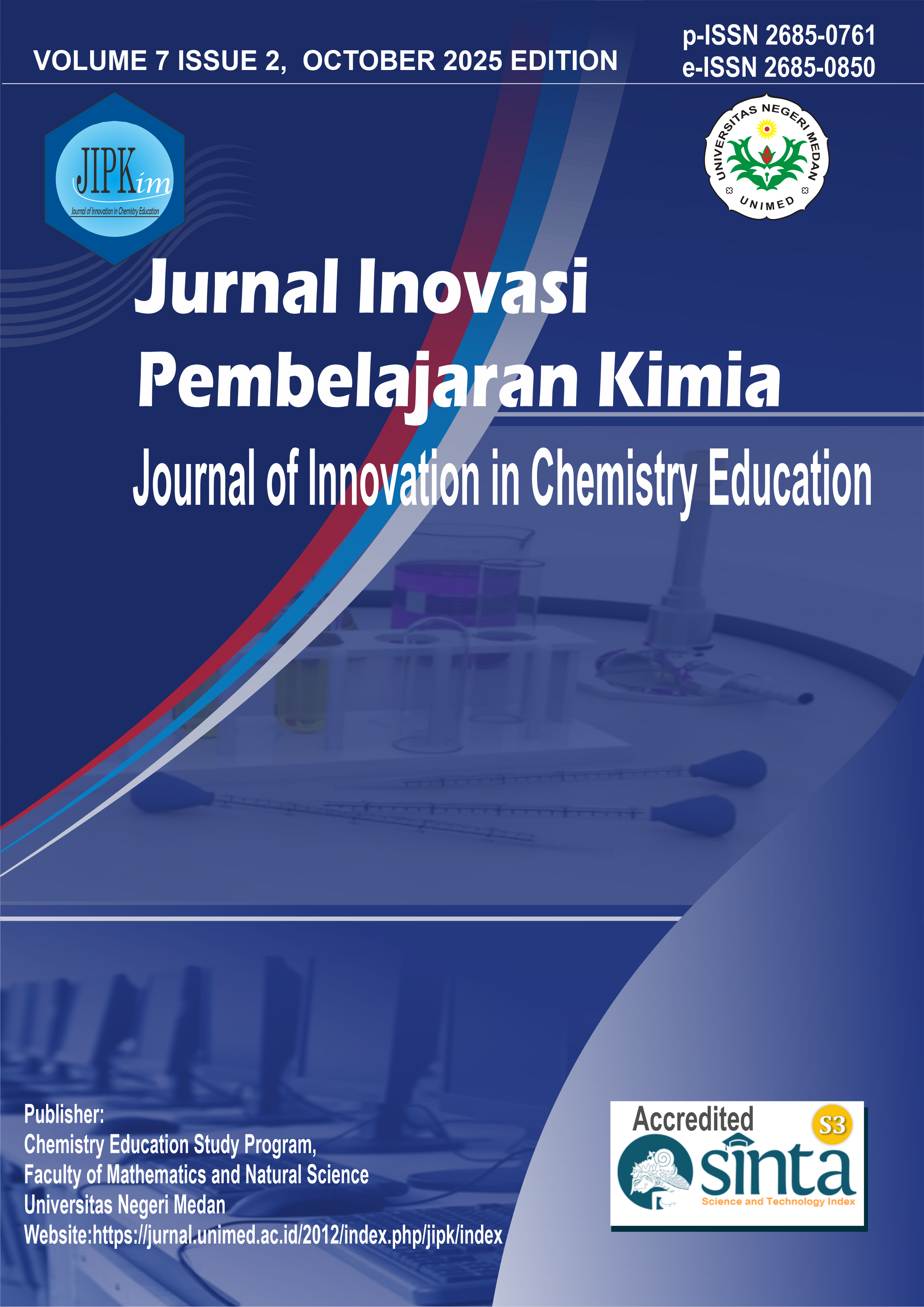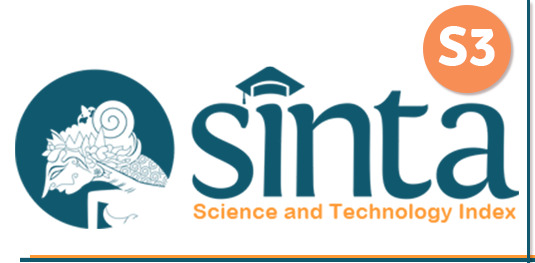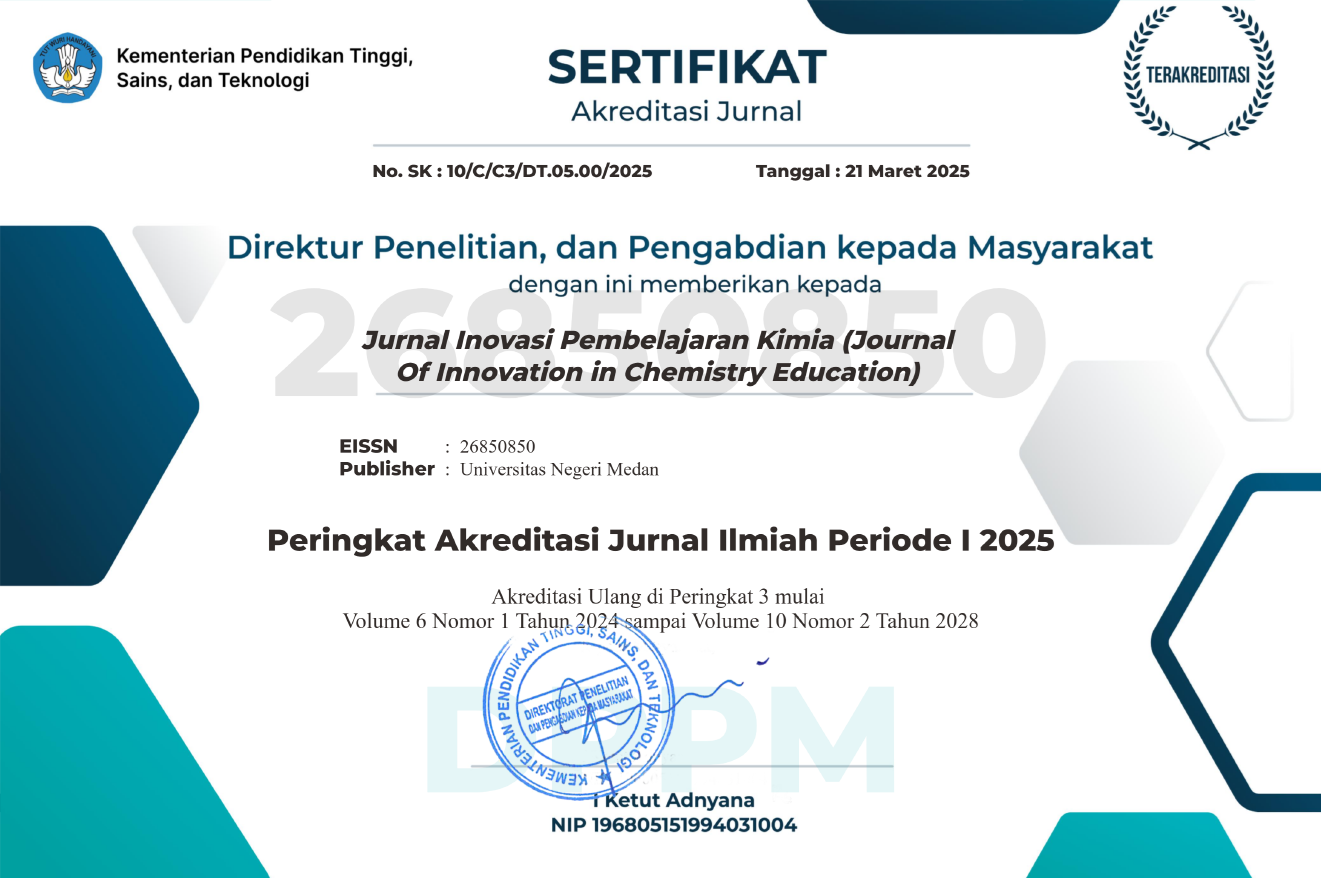Development of E-LKPD Project Based Learning Using Liveworksheet Integrated with Creative Thinking Skills
Keywords:
E-LKPD, Liveworksheet, Reaction Rate, Project Based Learning, Creative ThinkingAbstract
Reaction rate material involves both realistic and abstract concepts that require visualization and experimentation to better understand the influencing factors. Therefore, the use of a Project-Based Learning (PjBL) model is essential to connect theoretical knowledge with real-world contexts, enabling the creation of innovative and effective learning products that foster students’ creative thinking skills. This study aims to develop an e-LKPD using Liveworksheets based on PjBL for reaction rate material and to evaluate its effect on students’ creative thinking. The research employs the Lee and Owens Research and Development model using interviews, questionnaires, and pre-test–post-test instruments. Validation results from material and media experts indicate a high level of feasibility, while teacher assessments and student responses show strong satisfaction. The pre-test and post-test results reveal a significant improvement in creative thinking skills, with an N-Gain score of 0.6502. Overall, the developed e-LKPD is conceptually valid, practically applicable, and effective in enhancing creative thinking in chemistry learning, particularly in understanding reaction rate concepts.References
Andini, S. P., Leksono, S. M., & Vitasari, M. (2022). Pengembangan E-LKPD Berbasis Open Ended Problem Tema Pemanasan Global Untuk Melatih Kemampuan Berpikir Kreatif Siswa Kelas VII. PENDIPA Journal of Science Education, 6(3), 773–782. https://doi.org/10.33369/pendipa.6.3.773-782
Az-Zahra, S. A., & Darmana, A. (2024). The Relationship of Religiosity with Students’ Critical Thinking Skills on the Subject of Stoichiometry. Jurnal Inovasi Pembelajaran Kimia, 5(2), 163. https://doi.org/10.24114/jipk.v5i2.56227
Azizah, M., & Purba, J. (2025). Implementation of STEM-Based PBL with Quizizz and Mentimeter Media on Student Learning Outcomes. Jurnal Inovasi Pembelajaran Kimia, 7(1) 14–24.
Desmarani, S., Rusdi, M., Dewi, F., & Bakar, A. (2021). Pengembangan E-Lkpd Berbasis Inquiry-Flipped Classroom untuk Meningkatkan Kemampuan Berpikir Kreatif Peserta Didik pada Materi Ikatan Kimia. Universitas Jambi, 1–13.
Firtsanianta, H., & Khofifah, I. (2022). Efektivitas E-LKPD Berbantuan Liveworksheets Untuk Meningkatkan Hasil Belajar Peserta Didik. Conference of Elementary Studies, 140–147.
Ginting, P., & Purba, J. (2024). The Influence of the Problem Based Learning Model on Student Interest and Learning Outcomes. Jurnal Inovasi Pembelajaran Kimia, 6(1), 46. https://doi.org/10.24114/jipk.v6i1.57279
Hamsar, I & Qur’ani, B. (2024). Peningkatan Kererampilan Berpikir Kreatif Melalui Model Pembelajaran Project Based Learning (PjBL) Pada Siswa Kelas X SMPN 1 Galesong Utara. Pendas: Jurnal Ilmiah Pendidikan Dasar, 09, 1095–1105.
Indarta, Y., Jalinus, N., Waskito, W., Samala, A. D., Riyanda, A. R., & Adi, N. H. (2022). Relevansi Kurikulum Merdeka Belajar dengan Model Pembelajaran Abad 21 dalam Perkembangan Era Society 5.0. Edukatif : Jurnal Ilmu Pendidikan, 4(2), 3011–3024. https://doi.org/10.31004/edukatif.v4i2.2589
Ismail, R. N. M, & Neviyarni. (2019). Membangun karakter melalui Implementasi Teori Belajar behavioristik pembelajaran matematika berbasis kecakapan abad 21. Menara Ilmu, XIII(11), 76–88.
Kurniawan, F. S., Nafillah, K., & Kumara, R. B. (2024). The Development of SETS-Based E-Modules for Industrial Chemistry According to IMO Model Course 7.04. Jurnal Inovasi Pembelajaran Kimia, 6(2), 332. https://doi.org/10.24114/jipk.v6i2.64264
Lee, W. W., & Owens, D. L. (2004). Multimedia-Based Instructional Design.
Lioba, T., Yuniasih, N., & Nita, C. I. R. (2021). Pengembangan E-LKPD Berbasis Aplikasi Liveworksheets pada Materi Volume Bangun Ruang Kelas V SDN Kebonsari 4 Malang. Seminar Nasional PGSD UNIKAMA, 5(1), 307–313.
Minarni, M., Epinur, E., Yusnidar, Y., Syahri, W., Rusdi, R., & Afrida, A. (2023). Penggunaan Laboratorium Virtual Materi Laju Reaksi untuk Meningkatkan Hasil Belajar Siswa SMAN 3 Muaro Jambi. DEDIKASI: Jurnal Pengabdian Masyarakat, 5(1), 11. https://doi.org/10.32332/d.v5i1.6437
Mubarrok, A., & Wahyuni, F. T. (2023). Pengembangan E-LKPD Berbasis Open-ended Berbantuan Liveworksheets pada Materi Segiempat dan Segitiga untuk Meningkatkan Kemampuan Berpikir Kreatif Siswa Kelas VII MTs. JEID: Journal of Educational Integration and Development, 3(3), 180–188. https://doi.org/10.55868/jeid.v3i3.163
Muhammad, R, Febrianti, V. R., Afifah Nurhasanah, & Siti Nurdianti Muhajir. (2022). Telaah Literatur: Pengaruh Model Pembelajaran Project Based Learning (PjBL) terhadap Kreativitas Siswa Guna Mendukung Pembelajaran Abad 21. Jurnal Pembelajaran Inovatif, 5(1), 80–85. https://doi.org/10.21009/jpi.051.10
Muliardi, M. (2023). Mengembangkan kreativitas dan karakter bangsa melalui Kurikulum Merdeka di Madrasah. Takuana: Jurnal Pendidikan, Sains, Dan Humaniora, 2(1), 1–12. https://doi.org/10.56113/takuana.v2i1.68
Misrochah, M. (2021). Model Pengembangan Pembelajaran PJBL Berbasis Proyek untuk Meningkatkan Kreatifitas Siswa. Indonesian Journal of Learning Education and Counseling, 3(2), 140–147. https://doi.org/10.31960/ijolec.v3i2.741
Nasrullah, S. R., Lis, R., & Sari, P. (2025). Design of E-Assessment for Creative Thinking in Project-Based Learning on Colligative Properties of Solutions. 20, 1–13.
Oktaviana, E., Aima, Z., & Ramadoni, D. (2024). Pengembangan E-LKPD Berbasis Project Based Learning (PjBL) Berbantuan Aplikasi Liveworksheet Pada Materi Program Linear Kelas X SMK. Juring (Journal for Research in Mathematics Learning) P, 7(1), 31–044.
Permatasari, D., Destrinelli, & Sherly Pamela, I. (2023). Peningkatan Keterampilan Berpikir Kreatif Melalui Model Project Based Learning Pada Peserta Didik Kelas IV Sekolah Dasar. Journal on Education, 05(04), 16151–16164.
Prabawati, M. A., Yamtinah, S., & Sidiq, A. S. (2023). Literature Review : Pembelajaran IPA Bermuatan Etno-STEAM sebagai Upaya Pemberdayaan Kemampuan Berpikir Kreatif Siswa Kurikulum Merdeka. September, 166–179.
Purnawanto, A. T. (2022). Implementasi Profil Pelajar Pancasila dalam Kurikulum Merdeka. Jurnal Ilmiah Pedagogy, 21(1), 76–87.
Rachmawati, M., & Hidayah, R. (2024). Validity of Problem Based Learning Oriented E-LAPD for Practicing Creative Thinking Skills Reaction Rate Material. Jurnal Inovasi Pembelajaran Kimia, 6(2), 345. https://doi.org/10.24114/jipk.v6i2.61642
Rambe, A. P. (2024). Implementation of an Integrated Discovery Learning Model for Generic Science Skills on Acid - Base Material. Jurnal Ilmu Pendidikan Indonesia, 12(3), 205–218. https://doi.org/10.31957/jipi.v12i3.4014
Rizki, A., Nisa, K., & Nugraheni, A. S. (2021). Efektivitas Model Pembelajaran Berbasis Proyek.
Satria, T. G., & Egok, A. S. (2020). Pengembangan Etnosains Multimedia Learning Untuk Meningkatkan Kognitif Skill Siswa SD Di Kota LubukLinggau. Jurnal Basicedu, 4(5), 4(1), 13–21.
Simalango, M. & Situmorang, M. (2023). Project-Based Learning Resource Innovation to Build Students’ Critical Thinking Skills in Basic Teaching of Chromatography. Jurnal Inovasi Pembelajaran Kimia, 132–140. https://jurnal.unimed.ac.id/2012/index.php/jipk/article/download/54499/23468/123743
Siregar, T., Yawan, S. F., & Panggabean, F. T. M. (2024). Development of Contextual-Based Chemistry Module on Hydrocarbon Compound Materials. Jurnal Inovasi Pembelajaran Kimia, 6(1), 20. https://doi.org/10.24114/jipk.v6i1.56563
Suyono, A., & Hariyanto, S. (2014). Perkembangan teknologi informasi dan profesi penerjemah. JLT-Jurnal Linguistik Terapan Politeknik Negeri MalangJurnal Linguistik Terapan Politeknik Negeri Malang, 4(2), 56–62.
Zurweni, W, B., & Erwin, T. N. (2017). Development of collaborative-creative learning model using virtual laboratory media for instrumental analytical chemistry lectures. AIP Conference Proceedings, 1868. https://doi.org/10.1063/1.4995109













